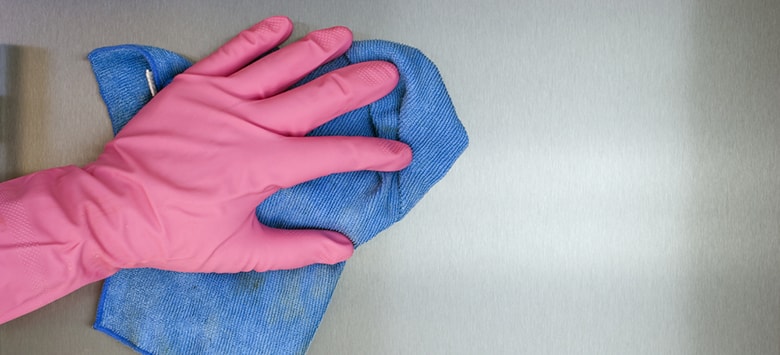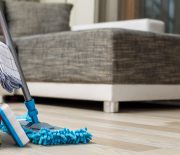Last update: 4 years ago

Metals are an indistinguishable part of our lives, thanks to their different properties, from jewellery and cutlery to entire surfaces. Yet, without cleaning metals properly, they lose their shine and beauty.
Often, we clean them as any other object. But metal objects require quite a bit of elbow grease to look spotless. Of course, you can use all of the specialized metal cleaners you can find on the shelves of almost any store. However, these metal cleaners may not be the best choice for everyone as many of them are quite harmful. We at Fantastic Cleaners are proponents of eco-friendly homemade detergents for cleaning metals and all other surfaces in that matter.
To clean metal as best as you can, you’ll need a little guidance. That’s why we’ve consulted with our professionals on the field on the best DIY methods for cleaning the different kinds of metals found in your home.
There is no universal way to clean all different metals. Some metal surfaces are softer, while others can take a beating. It’s good to know exactly what type of metal you will be cleaning. Otherwise, you may end up causing scratches and swirl marks on the surface of the metal.
Keep in mind that if the metal is heavily tarnished, you will need help from professionals. Sometimes, a DIY isn’t enough.
How to clean stainless steel
Stainless steel was first used in hospitals because it’s durable and easy to clean metal. Pure practicality. It’s no surprise it made its way inside our homes as well. Stainless, however, doesn’t mean this metal is impervious. If filth is left long enough on it, it can eat through the protective layer of chromium oxide and damage the metal.
The tools to clean stainless steel:
- Hot water
- Dishwashing liquid
- Cotton Cloth
- Rubbing alcohol
- Baking soda
- Glass cleaner
Cleaning stainless steel:
The simplest and most sparing method to clean stainless steel is to use hot water and a soft clean cotton cloth to wipe it. Because of its natural properties, stainless steel can be pretty easy to maintain clean. Like aluminium, it’s best to clean along the grain rather than perpendicular to it.
If plain water doesn’t do the trick, you can add a drop of dishwashing liquid to the water. This will probably help dissolve food leftovers, but if it doesn’t, there’s another way. Soak it in soapy water and then scrub it away with a soft sponge. Don’t use steel wool, as this can compromise the protective chromium oxide layer of the stainless steel.
Grease can also be dissolved with alcohol. Use rubbing alcohol on a soft dry cloth and rub the greasy spots until they are gone. Always dry off the metal once you are done with the cleaning to restore its natural shine.
For stubborn stains, you can use baking soda and water. Make a paste out of it and apply it to the stain. Mind that baking soda, just like salt, can be coarse and abrasive to the surface. It’s a good idea to test it out on a hidden spot before using this method on the entire surface. Once you are done, rinse with clean water so no baking soda is left and dry it off with a soft cloth.
As a finishing touch, use a damp clean cloth to wipe away the residue of the products you used. Then rinse the cloth and go over a second time. For a gleaming polish, use some glass cleaner.
How to clean chrome
Chrome is undoubtedly shiny but also quite soft. It’s used for decoration and some common everyday items such as faucets, pots, and pans. The thing is, these aren’t entirely made of chrome but are given a chrome layer as a finish. Despite being soft, chrome is quite durable at high temperatures. It’s also very easy to stain and cloud, and that’s why it’s important to know how to clean it without damaging it, as it’s a little different from cleaning any other metal.
What you’ll need to clean chrome:
- Dish Soap
- Microfiber Cloth
- Warm Water
- Vinegar
- Aluminum Foil
How to restore the chrome shine:
The first and most important thing about cleaning chrome is to not let it get dirty in the first place. As we said, chrome is rather soft, and the dirtier it gets, the more effort it will take to clean it. This, in turn, increases the risk of the chrome surface getting damaged in the cleaning process. As soon as you see your chrome starting to get clouded – wash it. Never wash chrome pots in greasy water because the grease will stain them, and it’ll be very difficult to remove.
To maintain chrome, water and dish soap, do the trick. Just fill a sink and give your chrome utensils and pots a good bath. Just remember what we told you about greasy water and chrome, and it will be fine. Use a soft cloth.
For more stubborn spots that water and soap couldn’t take care of, use vinegar. It doesn’t matter what type of vinegar is as long as it’s colourless. The acid in the vinegar will help get the tarnish right off. Dab a cloth in it and wipe. Just remember to use clean parts of the cloth for different areas. Otherwise, you may just layer the dirt.
For rusty spots on your chrome items, you can use a bit of aluminium foil dipped in vinegar. Scrub gently as not to harm the chrome finish. If the rust spots are heavy, you can use fine steel wool, but be very careful with it. Once you are done, rinse with water and dry it as chrome is notorious for developing water spots. Even more so than brass and copper.
How to clean aluminium
Aluminium is a very common metal, and it makes sense that it’s very commonly used in our households. From appliances to utensils and cutlery, the list is almost endless. The reason aluminium grows dull with time is oxidation. The aluminium oxide patina actually protects the metal, and it isn’t harmful to us. Clean, shiny aluminium is pleasant to the eye, so here’s how to keep it that way without harming it.
What you’ll need to clean aluminium:
- Water
- Clean Soft Cloth
- Coarse Fabric
- Water
- Vinegar
- Lemon
- Salt
The best method to clean aluminium:
Wash it thoroughly. No special trick. Water and dishwashing liquid are enough to clean this metal. Make sure it’s completely clean, and there is no grease left, as it may get in the way of the next steps. You can use some type of coarse fabric, like a cat scratchpad, for example. It works like a charm.
If there is burnt food at the bottom, put the vessel on the stove and pour water into it. Bring the water to a boil and use a wooden spoon to scrape the base until the aluminium pot is clean. Repeat as necessary.
For aluminium pots and items, a boiling solution of vinegar, lemon juice, or even just boiling an acidic fruit like a tomato can do the trick. Just fill it with water and a tablespoon of vinegar for every litre. Feel free to dump anything aluminium inside if it fits. This will get rid of the oxidation.
Avoid abrasive materials and detergents. Aluminium is a very soft metal and can easily be damaged by steel wool. You can use it as a last resort, but remember to always work with the metal’s grain, and never use a circular motion as it will make swirl marks.
For aluminium surfaces, we have a handy trick. Cut a lemon in half, dip it in salt, and gently rub the surface with it. Be careful as the salt grains can be a tad abrasive. If there is no lemon at hand, dab a washcloth in vinegar, sprinkle it with some salt and go to town on the aluminium surface!
How to clean copper
Copper’s natural colour when patinated can be quite pretty. These qualities make it perfect for decoration, but the metal has some pretty useful uses as well. Copper conducts heat very well and thus makes for high-quality cookware. It also has antimicrobial qualities to boot if you don’t like the patinated greenish hue read on to find out how to prevent it.
What you’ll need to clean copper patina:
- Magnet
- Dishwashing Liquid
- White Vinegar
- Baking Soda
- Salt
- Flour
- Soft Cloth
- Soft Bristled Toothbrush
- Virgin Olive Oil
Restore copper to its former glory:
First, you have to determine if what you are cleaning is copper or copper plated over another metal. You can do this with a magnet. If it sticks, then the item has copper plating. After you know what the material is, you must find out if it has a protective lacquer. Mix white vinegar with a tiny amount of baking soda and dab it on the surface. If it brightens immediately, that means there is no protective layer.
For items made entirely of copper and don’t have a protective finish, fill the sink with water and add some gentle dishwashing liquid. Let it sit for about 10 minutes and wash it. This will remove mineral deposits and loose debris. This method isn’t advisable for items that are just copper plated and/or have a lacquer finish. Use a damp cloth with a touch of soap, wash it thoroughly, and then rinse and dry off. This usually is enough but if you want gleaming copper – Read on!
A copper polishing paste is easy to mix with readily available products in your house. It’s made of salt, flour and white vinegar. Mix them into a thick paste. You don’t need to follow a particular recipe. Just don’t go overboard with the salt, as it can scratch the surface. Apply the paste to the copper item and let it sit for 10 minutes up to an hour, depending on how tarnished the metal is.
Now, use a soft cloth to scrub the paste away, and remember to go with the grain of the copper if possible. You can also use a soft-bristled toothbrush to do this. Once that’s done, rinse it thoroughly with water, buff it with a fresh soft cloth, and enjoy the fruits of your labour as the copper shines. Mind that copper hates water and stains easily from it, so make sure it’s completely dried off before storing it each time.
To protect your copper from stains and patina, simply rub a thin layer of virgin olive oil on it with a soft cloth. It’s less of a hassle than using a store-bought varnish, and it keeps the metal’s antimicrobial properties.
How to clean brass
Brass is an alloy made of copper and tiny amounts of zinc. In the household, it’s most often seen in decorative items, but it’s also used for elements such as doorknobs, faucets and even sinks. Just like copper, it can be cleaned with the same non-harmful method, requiring ingredients every household has.
What you’ll need to clean brass:
- Magnet
- Dishwashing Liquid
- White Vinegar
- Salt
- Flour
- Ketchup
- Soft Cloth
Cleaning and restoring brass:
As with copper, you first have to figure out if what you have is really brass or just another metal plated with brass. The magnet trick works just the same here – if it sticks, it’s not brass.
Brass is very similar to copper when it comes to cleaning, so giving it a bath in the sink will do the trick. Use soft cloths, and always remember to dry it off as quickly and as thoroughly as possible. Stop here if your items aren’t pure brass.
The paste you use to clean copper can just as well be used to clean brass. The method is the same.
You can also use ketchup to clean brass! Just slather it all and let it sit for about 10 minutes, then thoroughly clean and polish.
It’s no surprise, but brass hates water just as much as copper, so never let it sit wet.
How to clean silver
Silver is most often used for jewellery and decorative knick-knacks but also as a finish for fine cutlery. When worn as jewellery, the natural oils from our skin help it keep clean, but when stored, it can rather quickly become tarnished. This is because silver attracts trace amounts of sulphur from the air and covers itself with sulphur oxide. Using this relatively non-demanding and straightforward method, you can quickly return the shine of your silver items.
What you’ll need to clean silver:
- Dish Soap
- Pot
- Aluminum Foil
- Baking Soda
- Soft Cloth
Removing the patina from silver:
The first step is to simply wash your silver items with soapy water and dry them off. This will remove any regular grime from them and prime them for the next step. It may sound like alchemy at first, but it’s actually a pretty straightforward process.
Take a vessel and put it on the stove. It has to be big enough so you can put enough water to cover the items you want to clean thoroughly. Now line it with aluminium foil and fill it with enough water and add baking soda. A couple of spoons of baking soda will suffice for small silver vessels, but if you are cleaning silver platters or pots, you will need a bigger one and up to a cup of baking soda. Heat the water to boiling point. As soon as it begins to boil, remove it from the fire.
Now add your tarnished silver items. They have to be in direct contact with the aluminium foil for this to work. This method takes advantage of the fact that sulphur is more chemically attracted to aluminium than it is to silver. Move the silver pieces around until you notice yellow or black flakes in the water. This is the sulphur coming off. Take the silver items out from time to time to better observe the progress. Once satisfied, take them out.
Dry the items out with a clean, soft cloth. If there are remaining dark spots, just rub them off with the cloth and you are done. Your silver will be as shiny as new!
How to clean gold
As a noble metal, gold reacts with almost nothing naturally. It’s easy to clean but not impervious to grime. Thankfully the layer of dirt never really reacts with the metal. This means a rather simple solution of water and dishwashing soap is more than enough to keep it clean.
What you’ll need:
- Dishwashing Liquid
- Bowl
- Soft Cloth
- Toothbrush
Make gold shiny again:
First, make yourself a cleaning solution. It’s pretty simple, take a dish, put gentle dishwashing liquid in it, and dissolve it in water. You have to make sure the solution is even. Gently stir it until it happens if you have to.
Now put the gold-made jewellery in and give it 15 minutes to soak. This will loosen up grime and dissolve oils from the gold.
After the soaking is done, use a soft-bristled toothbrush or a jewellery cleaning brush if you have one and thoroughly scrub the gold item. Pay special attention to crevices and places where grime can stick.
After scrubbing it, put the item in a colander and give it a good rinse with warm water. Soap residue can stain gold, so you want to make sure there is none left. Dry it off by gently buffing it with a soft cloth, ensuring no moisture is left. Et voila! That is it.
Do you need a helping hand?
Hire a professional cleaning team!








